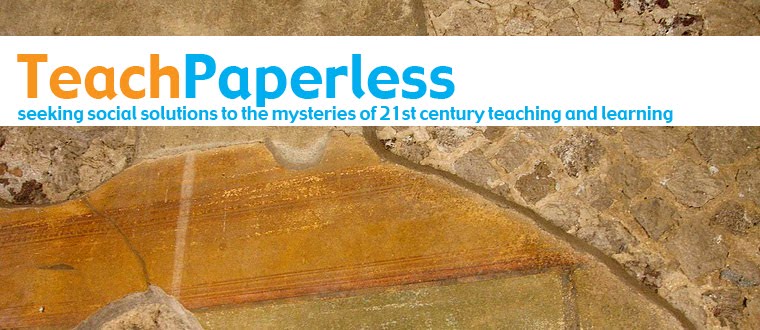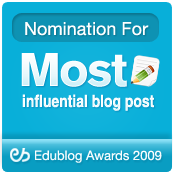Thursday, April 12, 2012
How to lecture in a PBL classroom
by Mike Kaechele
Disclaimer: I teach in a PBL school where every core class follows the PBL process. I am a firm believer in PBL as an excellent application of student-centered, constructivist learning. I believe that PBL is ONE effective way to teach and provides a clear structure for teachers to transition from a teacher-centered to student-centered classroom. I do NOT believe that it is the only way to effectively teach.
In reading comments to John Spencer's post about The Problem with PBL I felt like people have a bit of a narrow view of PBL. It felt like many define it as students engaged in a project, usually inquiry based. PBL at its heart and soul is a process that can include any teaching style in it including simulations, research, individual and group work, and yes even lecturing. So here is how lectures fit into the PBL model.
On a recent project on WWII students were considering the driving question "When is War Just?" They were required to present their findings to the class using the methods of their choice. I team teach with an ELA instructor and part of her requirements was that students submit a bibliography according to the MLA format. Students had done a very poor job of this on a previous project so we asked what we could do to make it better. She had already done whole class and small group, voluntary workshops (PBL lingo for lectures; I know the lingo is overkill, but don't shoot the messenger). Most students had not followed the instructions.
For this project we waited until the day before the project was due and required each group to send one member to the workshop on MLA format. This was very effective because students had their bibliographies "completed" but were able to see in the workshop any mistakes and fix them. This is how lectures are used in PBL-"just in time."
Instead of forcing a lecture on students who are uninterested, PBL encourages students to struggle and get stuck first. Then they can request a workshop on a topic that they need help on. Now they are ready to listen and get the help that they need. Frustration and struggle with a topic creates a need for the teacher lecture. Oftentimes attendance to a workshop is voluntary. Other times a teacher may require certain students to attend based on a formative assessment that shows weakness in a certain area. This allows the lecture to be focused on those students who need it when they need it.
So for those readers who say that PBL is part of a holistic education and not the whole. I am curious what other techniques do you use in the classroom that you do not feel fall under the umbrella of the PBL process?
Disclaimer: I teach in a PBL school where every core class follows the PBL process. I am a firm believer in PBL as an excellent application of student-centered, constructivist learning. I believe that PBL is ONE effective way to teach and provides a clear structure for teachers to transition from a teacher-centered to student-centered classroom. I do NOT believe that it is the only way to effectively teach.
In reading comments to John Spencer's post about The Problem with PBL I felt like people have a bit of a narrow view of PBL. It felt like many define it as students engaged in a project, usually inquiry based. PBL at its heart and soul is a process that can include any teaching style in it including simulations, research, individual and group work, and yes even lecturing. So here is how lectures fit into the PBL model.
On a recent project on WWII students were considering the driving question "When is War Just?" They were required to present their findings to the class using the methods of their choice. I team teach with an ELA instructor and part of her requirements was that students submit a bibliography according to the MLA format. Students had done a very poor job of this on a previous project so we asked what we could do to make it better. She had already done whole class and small group, voluntary workshops (PBL lingo for lectures; I know the lingo is overkill, but don't shoot the messenger). Most students had not followed the instructions.
For this project we waited until the day before the project was due and required each group to send one member to the workshop on MLA format. This was very effective because students had their bibliographies "completed" but were able to see in the workshop any mistakes and fix them. This is how lectures are used in PBL-"just in time."
Instead of forcing a lecture on students who are uninterested, PBL encourages students to struggle and get stuck first. Then they can request a workshop on a topic that they need help on. Now they are ready to listen and get the help that they need. Frustration and struggle with a topic creates a need for the teacher lecture. Oftentimes attendance to a workshop is voluntary. Other times a teacher may require certain students to attend based on a formative assessment that shows weakness in a certain area. This allows the lecture to be focused on those students who need it when they need it.
So for those readers who say that PBL is part of a holistic education and not the whole. I am curious what other techniques do you use in the classroom that you do not feel fall under the umbrella of the PBL process?
Subscribe to:
Post Comments (Atom)








I use a lot of informal writing, 1-2 minutes, in response to writing prompts with teens and adults. Informal writing is great with any kind of project because it forces students to set aside distractions to focus on some specific aspect of a topic or project. Rather than perhaps a third of students being ready to work on a project, everyone does the informal writing and thus all have begun thinking about it.
ReplyDeleteOf course, PBL can (and often should) include lectures - no matter what one believes they should or need to be called! The key is the just-in-time characterization. A key to any (student-centered, as it needs to be) learning is the TEACHER being a mentor; in school where learning the skills and habits that will become the "PBL" guideline for a successful career and personal life, the mentoring will often be best and most efficiently accomplished through the "lecture" - helping lots of people simultaneously. AND, really, how is this different from a situation well into one's career when an individual representing a team or not going to an EXPERT and getting verbal feedback? Seems the same to me ... The only bad features of this "lecture" in school are if they are not student-generated requests and, of course, if the teacher / mentor is not knowledgeable enough.
ReplyDeleteI commented a few minutes ago
... on the Spencer posting and tried to say things much as in this posting! DON'T GET HUNG UP WITH THE LINGO AS SUGGESTED!
DeleteThis is definitely an issue in peoples' understanding of PBL. In the Guide to PBL that we wrote with High Tech High, we put in some frequently-asked questions, one of which was 'Is teaching allowed?' (The answer was an emphatic yes)
ReplyDeleteI tend to describe PBL as a 'frame' or 'context' for learning' rather than as a discrete technique, because, as you say, you can do pretty much anything in the context of a project.
Shameless plug - you can download our guide from here: http://bit.ly/yV23Uf
Alec,
DeleteThank you kindly for your shameless plug! I am currently team teaching a unit on civic responsibility and students will create a video using Adobe Software that motivates the viewer to action, a PSA if you will. The guidelines and suggestions in your guide are going to be extremely helpful as we put together the parameters for our project. Thank you again!
Can anyone provide a great PBL project posted online that teaches late elementary or early middle school math? With students that arrive with math deficits, it seems to be really hard to do this...
ReplyDeleteThank you...
peace... J
I really wanted to say thanks for this kind of post and I highly recommended it, thanks again for sharing such a wonderful post! play online games | mobiles phones | Anime Wallpapers
ReplyDeleteThanks for your post, Mike. There's a useful paper called "A Time for Telling" (Schwartz & Bransford, 1998) that makes the case for just what you're describing. Bottom line, according to the authors: lectures and other sources of expert knowledge (i.e., texts)lead to deeper understanding when students first experience a "need to know."
ReplyDelete